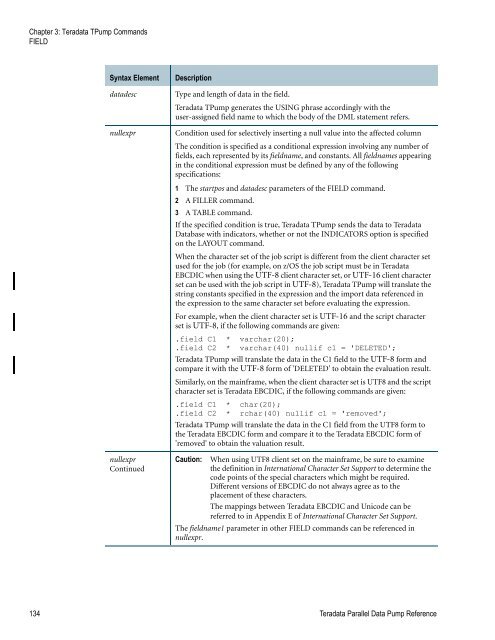Teradata Parallel Data Pump
Teradata Parallel Data Pump Reference - Teradata Developer ...
Teradata Parallel Data Pump Reference - Teradata Developer ...
- No tags were found...
You also want an ePaper? Increase the reach of your titles
YUMPU automatically turns print PDFs into web optimized ePapers that Google loves.
Chapter 3: <strong>Teradata</strong> T<strong>Pump</strong> Commands<br />
FIELD<br />
Syntax Element<br />
datadesc<br />
nullexpr<br />
nullexpr<br />
Continued<br />
Description<br />
Type and length of data in the field.<br />
<strong>Teradata</strong> T<strong>Pump</strong> generates the USING phrase accordingly with the<br />
user-assigned field name to which the body of the DML statement refers.<br />
Condition used for selectively inserting a null value into the affected column<br />
The condition is specified as a conditional expression involving any number of<br />
fields, each represented by its fieldname, and constants. All fieldnames appearing<br />
in the conditional expression must be defined by any of the following<br />
specifications:<br />
1 The startpos and datadesc parameters of the FIELD command.<br />
2 A FILLER command.<br />
3 A TABLE command.<br />
If the specified condition is true, <strong>Teradata</strong> T<strong>Pump</strong> sends the data to <strong>Teradata</strong><br />
<strong>Data</strong>base with indicators, whether or not the INDICATORS option is specified<br />
on the LAYOUT command.<br />
When the character set of the job script is different from the client character set<br />
used for the job (for example, on z/OS the job script must be in <strong>Teradata</strong><br />
EBCDIC when using the UTF-8 client character set, or UTF-16 client character<br />
set can be used with the job script in UTF-8), <strong>Teradata</strong> T<strong>Pump</strong> will translate the<br />
string constants specified in the expression and the import data referenced in<br />
the expression to the same character set before evaluating the expression.<br />
For example, when the client character set is UTF-16 and the script character<br />
set is UTF-8, if the following commands are given:<br />
.field C1 * varchar(20);<br />
.field C2 * varchar(40) nullif c1 = 'DELETED';<br />
<strong>Teradata</strong> T<strong>Pump</strong> will translate the data in the C1 field to the UTF-8 form and<br />
compare it with the UTF-8 form of 'DELETED' to obtain the evaluation result.<br />
Similarly, on the mainframe, when the client character set is UTF8 and the script<br />
character set is <strong>Teradata</strong> EBCDIC, if the following commands are given:<br />
.field C1 * char(20);<br />
.field C2 * rchar(40) nullif c1 = 'removed';<br />
<strong>Teradata</strong> T<strong>Pump</strong> will translate the data in the C1 field from the UTF8 form to<br />
the <strong>Teradata</strong> EBCDIC form and compare it to the <strong>Teradata</strong> EBCDIC form of<br />
'removed' to obtain the valuation result.<br />
Caution: When using UTF8 client set on the mainframe, be sure to examine<br />
the definition in International Character Set Support to determine the<br />
code points of the special characters which might be required.<br />
Different versions of EBCDIC do not always agree as to the<br />
placement of these characters.<br />
The mappings between <strong>Teradata</strong> EBCDIC and Unicode can be<br />
referred to in Appendix E of International Character Set Support.<br />
The fieldname1 parameter in other FIELD commands can be referenced in<br />
nullexpr.<br />
134 <strong>Teradata</strong> <strong>Parallel</strong> <strong>Data</strong> <strong>Pump</strong> Reference









